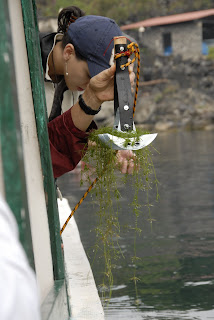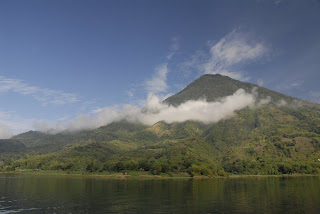The large boat docked in a bay in the south west of the lake (near Santiago) to get a series of water chemistry and phytoplankton samples. It was a very long day – the boat left for open water at 6:00 am and didn’t return until about 4:00 pm.
The large boat is great for some things, but not for others. One expedition member wanted to collect crabs and snails to understand how the lake’s chemistry is affecting the food chain. The small boat was able to find a local diver who was hunting for both.
Photos: crab diver with his day’s catch
We delivered the crabs and snails to the large boat, and were able to see Bob Richards and student Javier using the Van Dorn sampler, and sending the “messenger” down to close its bottom and top hatches, trapping water from the chosen depth.
Photos: Using the Van Dorn sampler
The watershed group traveled to the southern portion of the lake to see what kinds of nutrients, sediments, and other materials are coming into the lake. This section of the lakeshore is made up of porous, volcanic rock, so the runoff from near shore areas is minimal. The water was very clear, and comparisons to Lake Tahoe were mentioned several times.
Photo: rocky shoreline


The students who joined the watershed group today were with this group for the first time, having just rotated from the chemistry group. Eliska used some time to teach them about the different water plants present in the lake.
Photos: students learning to identify water plants.




After surveying the coastline from the boat, we navigated into a bay whose shores were less rocky. This calm water and flat land make the production and drying of “tul” possible.
Photo: Tul drying
Photo: Tul being ready to transport to market

The water plants are hosts to insects that can be used as bait for fishing.
Photo: fisherman collecting bait from water plants.

From this point, we hiked up the watershed, following a dry creek bed that drains the basin. Coffee and corn were grown in small plots. We soon arrived in a small town that had suffered greatly during the civil war. A memorial was installed, with the names of townspeople who had been killed or had disappeared. From here, we hired a truck to take us a short distance to the city of Santiago. This is a very busy town, full of men and women wearing traditional Mayan clothing. Many of the women’s white tops had beautiful birds stitched on them, a trademark for this town.
Our group was particularly interested in a 3-D model of Lago de Atitlan which was in the middle of the town square. It was great to see the lake from this perspective.
Santiago and surrounding towns were plaqued by violence during the 1980s due to its large Mayan population. We visited the local church, La Iglesia Parroquial Santiago Apostol (built between 1572 and 1581) to honor this history. This is where Father Stanley Rother, a missionary priest from Oklahoma, was murdered in 1981.
Photo: Steeple of La Iglesia Parroquial Santiago Apostol

Photo: A member of the mayor’s office discusses the lake with us on the church steps

The watershed group continued their exploration of the watershed by walking about Santiago and sampling various soil types. Teaching is an integral part of each activity.
Photo: Eliska Rejmankova discussing the differences between lab work and field work to the students who just rotated from the chemistry group

Photo: Mark Grismer teaching the students the techniques of soil sampling

Trash management is a challenge here, and Ishmael is making progress. He was the architect of the trash and recycling sorting project, which collects trash from nearby communities once a week.
Photo: Ishmael in front of a poster describing the recycling center.

Photo: Reclaimed plastic

Photos: soil sampling


Photo: one soil sample was collected at the top of this ridge, which was formed when mud from a mudslide created by Hurricane Stan was pushed up the valley with machinery.

We traveled back to the lake the same way water would.
Photo: walking down the watershed

The students have the minds of scientists: intelligent and curious about everything. The stratification of the soil generated many questions about the power of water over time. One of the students had been looking at insects all morning, and had expressed an interest in entomology. She was the student that stopped us to look at this soil, and when asked if she was interested in geology, stated, “I’m interested in everything!”
Photo: interesting soil layers

Photo: Mark Grismer teaching us about soil types

In the evening, Mark Grismer (UC Davis) gave a presentation on land use and watershed management.
Amber Roegner, UC Davis
I continue to be impressed with all the questions coming from students here on Expedition Atitlan. I joined this trip, initially, to collect water samples and possibly fish tissue samples for cyanotoxin analysis, but I hoped to become involved with the communities here and with student education. Little did I realize they would soon be educating me! “Why lethal dose 50 (LD-50)? I have always wanted to know,” asked Pablo. “And why do they use mice?” He was not asking me to explain fundamentals of toxicology; he was questioning assumptions underlying the fundamentals of toxicology. We then talked about the limitations of toxicology and how they could be improved. I have also had several eye- opening conversations about on-going monitoring both here at Atitlan and at Amatitlan, a eutrophic sister lake. I am certain that I will continue to correspond with several of the students that I have met here and hope to work with them in the future.
Photo: an image to remind you how special this lake is, Volcan San Pedro











No comments:
Post a Comment